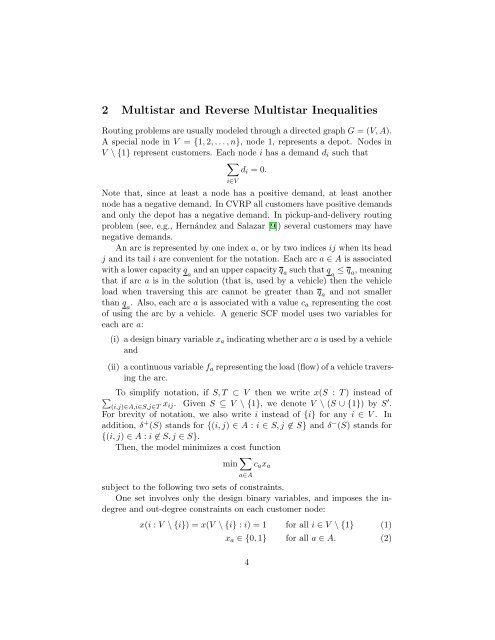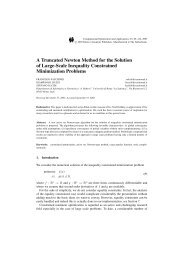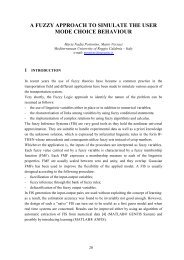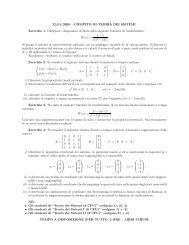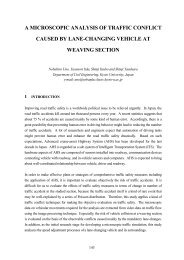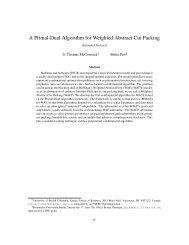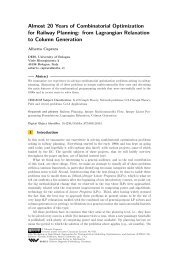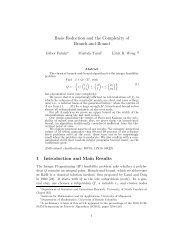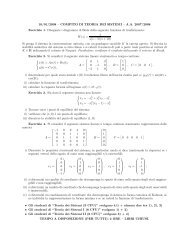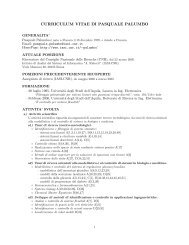Reverse Multistar Inequalities and Vehicle Routing ... - IASI-CNR
Reverse Multistar Inequalities and Vehicle Routing ... - IASI-CNR
Reverse Multistar Inequalities and Vehicle Routing ... - IASI-CNR
Create successful ePaper yourself
Turn your PDF publications into a flip-book with our unique Google optimized e-Paper software.
2 <strong>Multistar</strong> <strong>and</strong> <strong>Reverse</strong> <strong>Multistar</strong> <strong>Inequalities</strong><br />
<strong>Routing</strong> problems are usually modeled through a directed graph G = (V, A).<br />
A special node in V = {1, 2, . . . , n}, node 1, represents a depot. Nodes in<br />
V \ {1} represent customers. Each node i has a dem<strong>and</strong> di such that<br />
<br />
di = 0.<br />
i∈V<br />
Note that, since at least a node has a positive dem<strong>and</strong>, at least another<br />
node has a negative dem<strong>and</strong>. In CVRP all customers have positive dem<strong>and</strong>s<br />
<strong>and</strong> only the depot has a negative dem<strong>and</strong>. In pickup-<strong>and</strong>-delivery routing<br />
problem (see, e.g., Hernández <strong>and</strong> Salazar [9]) several customers may have<br />
negative dem<strong>and</strong>s.<br />
An arc is represented by one index a, or by two indices ij when its head<br />
j <strong>and</strong> its tail i are convenient for the notation. Each arc a ∈ A is associated<br />
with a lower capacity q a <strong>and</strong> an upper capacity q a such that q a ≤ q a, meaning<br />
that if arc a is in the solution (that is, used by a vehicle) then the vehicle<br />
load when traversing this arc cannot be greater than q a <strong>and</strong> not smaller<br />
than q a . Also, each arc a is associated with a value ca representing the cost<br />
of using the arc by a vehicle. A generic SCF model uses two variables for<br />
each arc a:<br />
(i) a design binary variable xa indicating whether arc a is used by a vehicle<br />
<strong>and</strong><br />
(ii) a continuous variable fa representing the load (flow) of a vehicle traversing<br />
the arc.<br />
To simplify notation, if S, T ⊂ V then we write x(S : T ) instead of<br />
<br />
(i,j)∈A,i∈S,j∈T xij. Given S ⊆ V \ {1}, we denote V \ (S ∪ {1}) by S ′ .<br />
For brevity of notation, we also write i instead of {i} for any i ∈ V . In<br />
addition, δ + (S) st<strong>and</strong>s for {(i, j) ∈ A : i ∈ S, j ∈ S} <strong>and</strong> δ − (S) st<strong>and</strong>s for<br />
{(i, j) ∈ A : i ∈ S, j ∈ S}.<br />
Then, the model minimizes a cost function<br />
min <br />
a∈A<br />
caxa<br />
subject to the following two sets of constraints.<br />
One set involves only the design binary variables, <strong>and</strong> imposes the indegree<br />
<strong>and</strong> out-degree constraints on each customer node:<br />
x(i : V \ {i}) = x(V \ {i} : i) = 1 for all i ∈ V \ {1} (1)<br />
xa ∈ {0, 1} for all a ∈ A. (2)<br />
4


